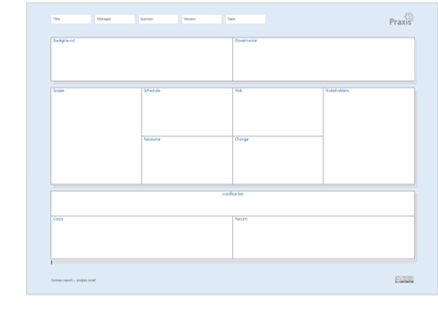The idea of a ‘canvas’ first arose in the form of the Business Model Canvas developed by Alexander Osterwalder1.
The main work looked at the strategic issues faced by a business start-up; the canvas is a simple but effective way of communicating the initial business model.
Since the launch of the Business Model Canvas, many people have adapted the principle to different business contexts. Since the set-up of projects and programmes has much in common with the set-up of a new business, it seems a natural step to apply this approach to communicating with stakeholders.
In fact, the ‘canvas approach’ seems ideally suited to presenting and communicating the project or programme brief. The canvas itself is one sheet of A3 split into three sections.
The first section deals with the background to the work and how it will be governed.
The second section covers the six areas of:
- Scope

- Schedule
- Risk
- Resource
- Change
- Stakeholders
Finally, the third section summarises the overall justification for the work and additional detail on the costs and returns on investment.
Clearly, the canvas cannot go into as much detail as a fully documented brief but it is an effective and highly visual way of communicating the headlines. Preparing it is, in itself, a good discipline for deciding what is really important about the project or programme.
It may even be that on smaller, non-complex projects, the canvas is all you need to get your message across at the end of the identification process.
Download a Microsoft Word A3 blank template here
Download an annotated Microsoft Word A3 template here
- Business Model Generation, Osterwalder A, Pigneur Y, Smith A, self-published, 2010





